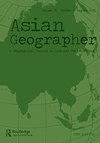The rural lands of urban sprawl: institutional changes and suburban rurality in Santiago de Chile
IF 2.2
Q2 GEOGRAPHY
引用次数: 10
Abstract
ABSTRACT Urban sprawl has been mainly discussed in regard to its negative impacts. However, there is a variety of rural lands that benefit the suburbanization process in social, environmental, economic and political terms. These lands configure a category of rurality rarely considered as part of the urban phenomenon, and usually seen as pending space for further (sub)urbanization. In this sense, planning regimes and institutional changes tend to transform suburban rurality into marketable residential space, triggering reactions of preservation and change. With regard to the capital city of Chile – Santiago – it is argued that the meanings about the “urban”, the “rural” and the “city” become disputable in the light of suburban rurality and problematic as direct antonyms or unequivocal synonyms. It is also demonstrated that despite dramatic institutional changes, suburban rurality can survive over time if it finds support in social organizations and alternative planning rationales. The research in which this paper is based was conducted in five years and included the revision of several leftover interstitial spaces in which suburban rurality emerges as one of the most meaningful categories of suburban space. To gain further understanding on suburban rurality, this paper is based on a qualitative approach – including semi-structured interviews and archival revision of historical documents and policy reports – and focuses on the southern geographical space of the metropolitan area of Santiago de Chile, where most of social housing developments have been located over the last 60 years.城市扩张的农村土地:智利圣地亚哥的制度变迁和郊区农村
摘要城市蔓延主要从其负面影响方面进行讨论。然而,在社会、环境、经济和政治方面,有各种各样的农村土地有利于郊区化进程。这些土地构成了一种很少被认为是城市现象的一部分的乡村类型,通常被视为进一步(次)城市化的待决空间。从这个意义上说,规划制度和制度变化倾向于将郊区乡村转变为可销售的居住空间,引发保护和变化的反应。就智利首都圣地亚哥而言,“城市”、“农村”和“城市”的含义在郊区农村的背景下变得有争议,作为直接反义词或明确的同义词也存在问题。研究还表明,尽管发生了巨大的制度变化,但如果能在社会组织和其他规划理论中找到支持,郊区乡村性仍能存活下来。本文所依据的研究历时五年,包括对几个剩余空间的修正,其中郊区乡村性成为郊区空间中最有意义的类别之一。为了进一步了解郊区乡村性,本文基于定性方法——包括半结构化访谈和对历史文件和政策报告的档案修订——并将重点放在智利圣地亚哥大都市区的南部地理空间上,在过去的60年里,大多数社会住房开发都位于这里。
本文章由计算机程序翻译,如有差异,请以英文原文为准。
求助全文
约1分钟内获得全文
求助全文
来源期刊

Asian Geographer
GEOGRAPHY-
CiteScore
3.30
自引率
0.00%
发文量
7
期刊介绍:
Asian Geographer disseminates knowledge about geographical problems and issues focusing on Asia and the Pacific Rim. Papers dealing with other regions should have a linkage to Asia and the Pacific Rim. Original and timely articles dealing with any field of physical or human geographical inquiries and methodologies will be considered for publication. We welcome, for example, submissions on people-environment interactions, urban and regional development, transport and large infrastructure, migration, natural disasters and their management, environment and energy issues. While the focus of the journal is placed on original research articles, review papers as well as viewpoints and research notes under the category of “Asian Geography in Brief” are also considered. Review papers should critically and constructively analyse the current state of understanding on geographical and planning topics in Asia. The ‘Asian Geography in Brief’ section welcomes submissions of applied geographical and planning research about Asia. The section aims to showcase (1) the diverse geography and planning of Asia; and (2) the diverse geographical and planning research about Asia. The journal will also publish special issues on particular themes or areas. Book reviews can be included from time to time.
 求助内容:
求助内容: 应助结果提醒方式:
应助结果提醒方式:


